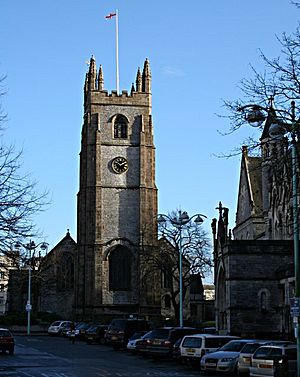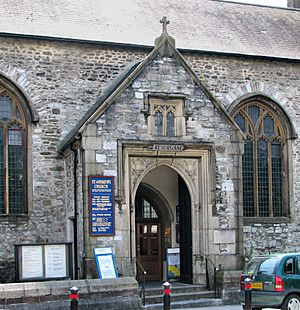St Andrew's Church, Plymouth facts for kids
Quick facts for kids St Andrew's Church, Plymouth |
|
|---|---|
| Minster Church of St Andrew | |

Tower of St Andrew's Church
|
|
| Location | Royal Parade, Plymouth, PL1 2AD |
| Country | England |
| Denomination | Church of England |
| Churchmanship | Evangelical |
| History | |
| Status | Active |
| Architecture | |
| Functional status | Parish church |
| Administration | |
| Parish | St. Andrew Plymouth |
| Deanery | Plymouth City |
| Archdeaconry | Archdeaconry of Plymouth |
| Diocese | Diocese of Exeter |
The Minster Church of St Andrew, also known as St Andrew's Church, Plymouth, is an Anglican church in Plymouth, England. It was the first parish church for Sutton, one of the towns that later formed the city of Plymouth. This church is the largest parish church in the historic county of Devon. It was built between the mid and late 1400s.
During World War II, the church was badly damaged by bombs. However, it was rebuilt after the war. In 2009, it was named a Minster Church. Today, it is an important place for city events and a busy church. It is believed to stand on the site of an even older Saxon church.
Contents
History of St Andrew's Church
The church has been around since at least the early 1000s. It might have been built as early as the 700s. By the 1400s, the town was growing, so the church needed to be made bigger.
Building the Church
Most of the church you see today was built between 1430 and 1490. It was made from local Plymouth limestone and Dartmoor granite. A plaque on the tower shows it was finished around 1460. The church is 185 feet (56 meters) long and 96 feet (29 meters) wide. It has two aisles on each side of the main area (the nave) and one on each side of the chancel (the area near the altar).
The church tower is 136 feet (41 meters) tall. A rich merchant named Thomas Yogge helped pay for it around 1460. The church has been repaired three times over the years. Important repairs happened in 1824, 1875, and after it was bombed in World War II.
The Organ and Music
The church has a very large organ, which is the biggest west of Bristol. It was designed by several people, including George Harry Moreton. Dr. Harry Moreton was the church's organist for a very long time, from 1885 to 1958.
The Plymouth Blitz and Rebuilding
In March 1941, during World War II, St Andrew's Church was bombed. It was badly damaged. After the bombing, a headmistress bravely put a wooden sign on the door. It simply said Resurgam, which is Latin for I shall rise again. This showed the strong spirit of the people during the war.
This entrance is still called the "Resurgam" door today. There is now a carved granite plaque there to remember this moment. The church was rebuilt and given a new roof. It was officially opened again on November 30, 1957, which is St Andrew's Day.
Important People Connected to the Church
Many famous people have connections to St Andrew's Church.
Notable Visitors and Events
- Katherine of Aragon: She visited the church to give thanks for a safe sea journey from Spain.
- Francis Drake: A famous explorer and sailor.
- Martin Frobisher: Another well-known explorer.
- John Hawkins: A famous naval commander.
- King Charles II: It is said that he performed a special healing touch here for people with a certain illness.
- Admiral Robert Blake: A great naval leader. His body was first buried here, but later moved to Westminster Abbey. However, his heart is still believed to be buried under the church.
- William Bligh: He was baptized here in 1754. He later became famous for the Mutiny on the Bounty.
Past Clergy Members
Several important church leaders started their careers or served at St Andrew's:
- John Cavell: He was the Vicar from 1962 to 1972. He later became a bishop.
- Joseph Hunkin: He started as a curate (an assistant priest) here in 1914. He later became the Bishop of Truro.
- Nick McKinnel: He was the rector from 1994 to 2012. He later became the Bishop of Plymouth.
- Clifford Martin: He was the vicar from 1939 to 1944. He later became the Bishop of Liverpool.
- Rod Thomas: He was a curate here from 1993 to 1999. He later became a bishop.
Images for kids



